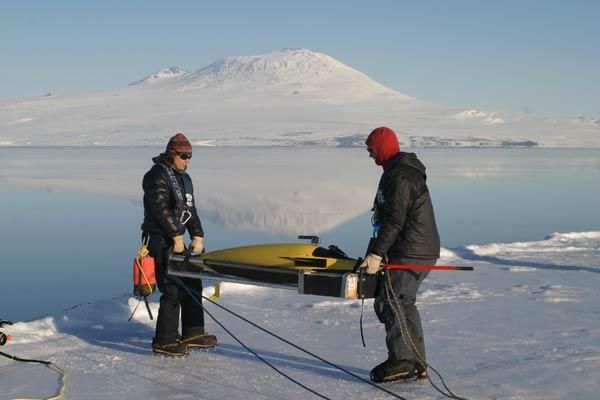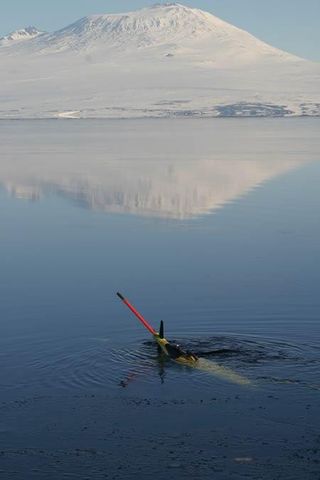
'Ice Dragon' Robot Sub Probes Antarctic Waters

A robot dubbed the Ice Dragon has been roaming the frigid waters of Antarctica's Ross Sea since late November 2010. This week, scientists set sail to rendezvous with the motorless glider, which has been collecting data on ocean conditions since its launch, and has set two world records along the way.
Last year, Walker Smith, a veteran researcher at the Virginia Institute of Marine Science (VIMS), dispatched the 114-pound (52-kilogram) glider through a hole in the Antarctic ice the hole was made by whales coming up for air.
The launch was the most southerly glider deployment ever. A short (and unintentional) jog off course also made it the first-ever glider to successfully dive beneath the Ross Ice Shelf.
As of this week, the glider has completed more than 780 dives of about two hours each, to depths of 2,330 feet (700 meters). And although it moves slowly no more than a half-mile an hour the Ice Dragon has traveled around 871 miles (1,402 kilometers) so far. (Another robotic glider is exploring the floodwaters flowing into the coastal ocean areas off Brisbane, Australia.)
Sensors on the glider's fiberglass hull measure water temperature, salinity, levels of dissolved oxygen and chlorophyll an indicator of the abundance of phytoplankton, the single-celled plants that are the food source of many ocean residents.

At the end of each dive, the glider flips its tail into the air so that its antenna can send the collected data to researchers via satellite, and receive guidance for its next dive.
Because it's propelled by changes in buoyancy rather than an energy-hungry motor, the SG503 Ice Dragon can remain in the water for months at a time before needing a recharge.
Sign up for the Live Science daily newsletter now
Get the world’s most fascinating discoveries delivered straight to your inbox.
Smith said this kind of longevity is invaluable for researchers trying to better understand how swiftly changing ocean conditions may affect larger phenomena like phytoplankton blooms an explosion in the population of the miniscule plants.
"Our glider will help detail the physical and biological oceanography of the southern Ross Sea by sampling the region continuously through the growing season," Smith said. "Given its ability to repeatedly sample specific areas, it holds great promise for resolving short-term and seasonal trends."
Mark Patterson, head of the Autonomous Systems Laboratory at VIMS, said that low-power gliders and other AUVs hold great promise for solving one of the oldest problems in oceanography: the fact that "the ocean changes faster than we have the ability to observe."
"Traditional ship-based studies can only provide snapshots of the constantly changing ocean ecosystem," Patterson said. "That's like trying to figure out what's going on in a TV series like 'Lost' by watching just one or two episodes per year."
Smith and colleagues will retrieve the SG503 Ice Dragon in early February. They'll spend several weeks aboard a research vessel comparing their shipboard measurements of water temperature, salinity, dissolved oxygen and chlorophyll to those recorded by the glider to ensure that the robot's sensors are still accurately calibrated after more than two months in the water.
Until then, the glider will continue to conduct dives and collect data.
- Creatures of the Frozen Deep: Images of Antarctica's Sea Life
- Upgraded Sub Could Reach 98 Percent of Ocean Deep
- The Coldest Places on Earth
Reach Andrea Mustain at amustain@techmedianetwork.com. Follow her on Twitter @AndreaMustain.












